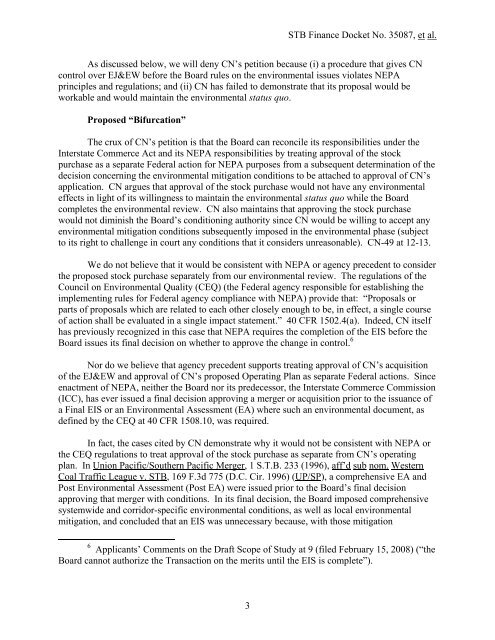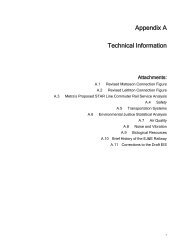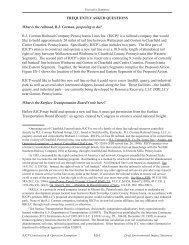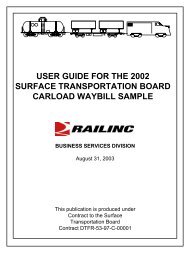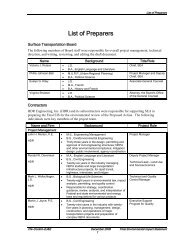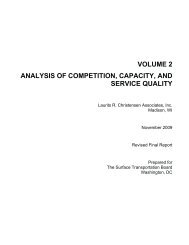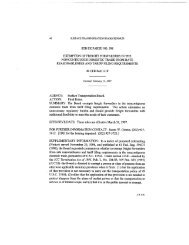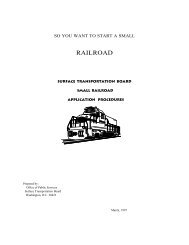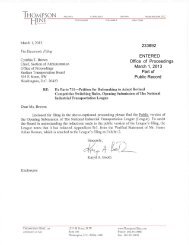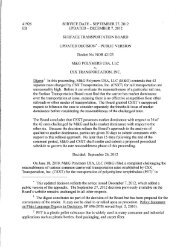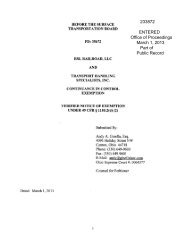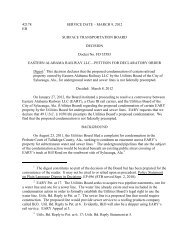Attachments - Surface Transportation Board - U.S. Department of ...
Attachments - Surface Transportation Board - U.S. Department of ...
Attachments - Surface Transportation Board - U.S. Department of ...
You also want an ePaper? Increase the reach of your titles
YUMPU automatically turns print PDFs into web optimized ePapers that Google loves.
STB Finance Docket No. 35087, et al.<br />
As discussed below, we will deny CN’s petition because (i) a procedure that gives CN<br />
control over EJ&EW before the <strong>Board</strong> rules on the environmental issues violates NEPA<br />
principles and regulations; and (ii) CN has failed to demonstrate that its proposal would be<br />
workable and would maintain the environmental status quo.<br />
Proposed “Bifurcation”<br />
The crux <strong>of</strong> CN’s petition is that the <strong>Board</strong> can reconcile its responsibilities under the<br />
Interstate Commerce Act and its NEPA responsibilities by treating approval <strong>of</strong> the stock<br />
purchase as a separate Federal action for NEPA purposes from a subsequent determination <strong>of</strong> the<br />
decision concerning the environmental mitigation conditions to be attached to approval <strong>of</strong> CN’s<br />
application. CN argues that approval <strong>of</strong> the stock purchase would not have any environmental<br />
effects in light <strong>of</strong> its willingness to maintain the environmental status quo while the <strong>Board</strong><br />
completes the environmental review. CN also maintains that approving the stock purchase<br />
would not diminish the <strong>Board</strong>’s conditioning authority since CN would be willing to accept any<br />
environmental mitigation conditions subsequently imposed in the environmental phase (subject<br />
to its right to challenge in court any conditions that it considers unreasonable). CN-49 at 12-13.<br />
We do not believe that it would be consistent with NEPA or agency precedent to consider<br />
the proposed stock purchase separately from our environmental review. The regulations <strong>of</strong> the<br />
Council on Environmental Quality (CEQ) (the Federal agency responsible for establishing the<br />
implementing rules for Federal agency compliance with NEPA) provide that: “Proposals or<br />
parts <strong>of</strong> proposals which are related to each other closely enough to be, in effect, a single course<br />
<strong>of</strong> action shall be evaluated in a single impact statement.” 40 CFR 1502.4(a). Indeed, CN itself<br />
has previously recognized in this case that NEPA requires the completion <strong>of</strong> the EIS before the<br />
<strong>Board</strong> issues its final decision on whether to approve the change in control. 6<br />
Nor do we believe that agency precedent supports treating approval <strong>of</strong> CN’s acquisition<br />
<strong>of</strong> the EJ&EW and approval <strong>of</strong> CN’s proposed Operating Plan as separate Federal actions. Since<br />
enactment <strong>of</strong> NEPA, neither the <strong>Board</strong> nor its predecessor, the Interstate Commerce Commission<br />
(ICC), has ever issued a final decision approving a merger or acquisition prior to the issuance <strong>of</strong><br />
a Final EIS or an Environmental Assessment (EA) where such an environmental document, as<br />
defined by the CEQ at 40 CFR 1508.10, was required.<br />
In fact, the cases cited by CN demonstrate why it would not be consistent with NEPA or<br />
the CEQ regulations to treat approval <strong>of</strong> the stock purchase as separate from CN’s operating<br />
plan. In Union Pacific/Southern Pacific Merger, 1 S.T.B. 233 (1996), aff’d sub nom. Western<br />
Coal Traffic League v. STB, 169 F.3d 775 (D.C. Cir. 1996) (UP/SP), a comprehensive EA and<br />
Post Environmental Assessment (Post EA) were issued prior to the <strong>Board</strong>’s final decision<br />
approving that merger with conditions. In its final decision, the <strong>Board</strong> imposed comprehensive<br />
systemwide and corridor-specific environmental conditions, as well as local environmental<br />
mitigation, and concluded that an EIS was unnecessary because, with those mitigation<br />
6 Applicants’ Comments on the Draft Scope <strong>of</strong> Study at 9 (filed February 15, 2008) (“the<br />
<strong>Board</strong> cannot authorize the Transaction on the merits until the EIS is complete”).<br />
3


